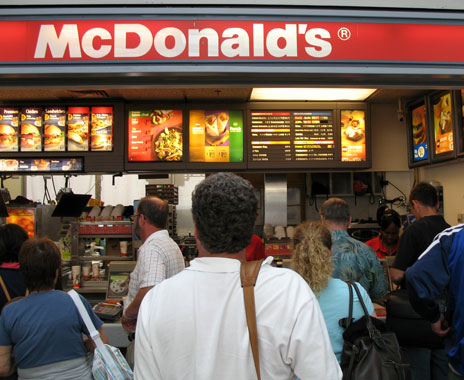Twenty minutes. That’s the average time customers typically spend dining in a quick-service restaurant. With so little time to make an impression, restaurateurs must pay careful attention to every consumer touchpoint. Forward-thinking franchisees have taken cues from the hospitality industry, creating what’s been coined the “third space.” In lieu of the home (first space), and the office (second space), the third space is a shared environment that inspires congregation and fosters community.
As an industry that experienced explosive growth in the 1980s and 90s, many existing quick-service restaurants remain vestiges of the past, both aesthetically and technologically. By refining the experiential component of quick-service restaurants with sensorial marketing tactics, progressive restaurateurs are creating uniquely different dining experiences, ultimately differentiating themselves from the competition. The key components of the space must be equal parts accessible, comforting and welcoming.
Aesthetically speaking, stainless steel, thick glass and linear rows of plastic chairs are not what today’s consumer finds welcoming. The quick-service restaurant space has begun to mirror the hospitality industry by implementing a range of fresh, more inviting materials. We’re seeing an emergence of ambient lighting, rich textures, eclectic furniture, and common spaces with varying elevations—making quick-service restaurants homier and encouraging customers to stick around. Successful franchisees are oftentimes delineating specific zones to different activities and customer types—to create a mix of communal areas, quiet workspaces, media areas and kids’ play zones. Having catered, dedicated areas that speak to and connect with target customers helps to build loyalty and repeat visits.
The open kitchen concept has also been introduced, lending transparency to ingredients and food prep. Plus, distracting kitchen noise can be isolated by having supporting audio for TV programming or music to be heard, depending on the specific zone. Unsavory smells such as cleaners and detergents have also been minimized with tailor-made aromas wafted throughout eateries. Warm sugar cookie and apple pie scents are regularly infused, creating a cozy atmosphere. There’s evidence that scent is a powerful tool that can have an enormous impact on customer perception of both a restaurant and its food quality. If a quick-service restaurant harnesses scent in an authentic way, the results can be measurable.
To create homey third spaces where customers are entertained and encouraged to linger, quick-service restaurants need to refine the experiential component as well. As mentioned earlier, the average stay is typically twenty minutes. While customers can’t commit to a full-length TV program, there’s still a need to provide visual stimuli. Historically speaking, quick-service restaurant TV programming has streamed news, sports or entertainment. Rather than broadcasting polarizing political news, strategic quick-service restaurants are increasingly turning to using customized TV programming with small, snackable segments, or “nuggets” of content that are thought-provoking and reinforce brand values. Content is critical to prudently ensure family-friendly atmospheres devoid of competitive commercials, unappetizing visuals or inappropriate storylines. Translation: Entertainment that doesn’t offend the masses.
But before customers even take a seat, let’s talk ordering. Personalization is a ubiquitous buzz word these days. As such, we’re seeing a move toward kiosk ordering systems that allow customers to personalize their Big Mac orders on iPad-like devices. Consumers are getting increasingly savvy at ordering on touchscreens versus traditional counter ordering. If the trend persists, kiosks will undoubtedly cut labor and operation costs.
Table service is also becoming more prevalent. Customers can oftentimes place an order and settle into a curated leisure zone to have their food delivered. Rather than traditional table numbers, location-based table tagging is in the works, utilizing both WiFi and Bluetooth beacons. Panera Bread has been leading the charge, employing table pagers that map back to the kitchen. When a customer’s order is ready, the staff knows precisely which table to deliver food to—no number holders required.
Similarly, drive-thru tagging is also becoming more widespread. Mobile ordering is on the rise, and we’re seeing an increasing number of customers order via smartphone and utilize the drive-thru window to pick up orders. With 70 percent of quick-service restaurant business taking place in the drive-thru, franchisees now have the technology to tie mobile ordering to Bluetooth beacons. Sensors on the perimeter of quick-service restaurants notify staff when a customer who has placed an order online pulls into the parking lot. Geolocation through Bluetooth or a tagging device lets quick-service restaurant teams know exactly when to start prepping the order, minimizing both cold fries and customer wait times.
Undoubtedly, there’s been considerable progress in the way of curated quick-service restaurant experiences. But what does the future hold? Increased personalization. We’ll begin to see customers interact with in-store screens via personal mobile devices, whether it’s gamification or influencing a restaurant’s playlist. A handful of Los Angeles-based McDonald’s are already ahead of the pack, allowing customers to influence in-store music and participate via Social Mix.
The truth is, consumers these days are faced with more choices than ever before and they’re becoming increasingly sophisticated. Expectations are at an all-time high and customers will continue to demand exceedingly customized experiences. With a mere twenty minutes to engage, excite and entertain, quick service restaurants should be ready to actualize the appropriate environment to satiate customers’ needs before they even ask.












